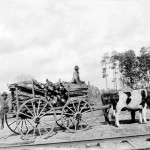Georgia transportation is deeply linked with state’s economic history; the growth of our state has been shaped by the maintenance and expansion of transportation systems that include highways, railroads, ports, and air travel. Today, Georgia is home to one of the world’s busiest airports, Hartsfield-Jackson International Airport, as well as one of America’s fastest-growing ports in Savannah; the state is also a regional hub for road and rail travel. For a complete list of DLG collections with significant content pertaining to transportation in Georgia, see http://dlg.galileo.usg.edu/Topics/Transportation.html. Here are some highlights from those collections.

The photograph above of two African American boys riding a cart led by two oxen represents Georgia rural transportation at the turn of the century; the photograph indicates that travel in rural areas incorporated modern technology (seen in the railroad tracks at the foreground of the photograph) along with animal-powered farm vehicles.

The photograph above is of an early automobile being driven on an unpaved road, sometime between 1910 and 1919. Today, Georgia drivers can traverse more than 117,000 miles of public roads, which include county roads, state highways, city streets, and interstate highways. These roads are maintained by the Georgia Department of Transportation with a combination of funds raised from automobile fuel taxes, state taxes, and federal funding. The photograph below is a still shot from a 1964 newsfilm clip of a driving safety exposition.


Railroads were first built in Georgia during the 1830s. Atlanta, which was well-situated for rail transport, became a focal point of railroad travel and commerce for the entire Southeast; during the Civil War, the city was seized by Union forces to ensure that supplies could not be sent to Confederate troops by rail. After the Civil War, new railroad lines were built and incorporated into larger rail systems, such as the Central of Georgia, Southern Railway, the Atlantic Coast Line, and the Seaboard Air Line Railway. Some of these rail systems are described in the publication A History of Transportation in the Eastern Cotton Belt to 1860, by Ulrich Bonnell Phillips, available as part of the Georgia-related Publications from the Hathi Trust Digital Library collection. Rail travel declined in popularity during the 1920s, as automobile and road travel became more convenient and affordable for both passenger and freight transport. Today, passenger service through Georgia is represented in two Amtrak routes, and freight is transported across the state by two carriers: CSX and Norfolk Southern across approximately 5,000 miles of railroad tracks. The photograph above includes a local passenger street rail car from the early 1890s that was part of the Atlanta and Edgewood Street Railroad ; the photograph below shows a rail-to-dock cargo connection at a Savannah port in 1930.

Many of Georgia’s first cities were built based upon their proximity to water transportation. Travel by canal and river ensured that materials grown or processed inland could be carried out to coastal deep-water cargo facilities of Savannah and Brunswick. Although railroads became a more popular method of transporting cargo at the turn of the twentieth century, barge transportation was developed and incentivized during the mid-20th century in inland port cities such as Bainbridge (around 1957) and Columbus (around 1961) to ensure the efficient travel of commodities. The photograph below features a steamboat carrying bales of cotton down the Ocmulgee River in 1897.

Ben Epps became Georgia’s first aviator when he flew his first plane in Athens in 1907. More than one hundred years later, Georgia hosts one of the world’s busiest airports, Hartsfield-Jackson Atlanta International Airport, one of 107 public use airports across the state. Many of Georgia’s public use airports were formerly military air bases used during World War II that were ultimately turned over to city and county governments. Georgia’s vibrant air transportation industry attracts commercial activity from outside of the state, and serves many millions of passengers annually. The photographs below include an airplane built by Ben Epps, and a naval airship squadron parked inside of an air station hangar in Glynn County.


MARTA (Metropolitan Atlanta Rapid Transit Authority), the ninth largest mass transit system in the United States, provides rail and bus service to the metropolitan Atlanta area. The photographs below show a predecessor of modern bus transportation in an open passenger bus from approximately 1914-1915, and a shot of a MARTA train traveling by the airport.


Numerous collections also show transportation’s role in Georgia recreational life. Several recreational shots include: an 1897 photograph of a group of Atlanta bicyclists gathered around their bicycles, a photo of a young boy riding a miniature motorcycle in 1948, and a still from an international automobile show.



Transportation is an integral part of Georgia’s industrial and recreational life; highways, railroads, ports, mass transit, and air travel have helped secure Georgia’s role as a national and international commercial center. The state’s growth and prosperity is due in large part to its success in finding ways to innovatively move people and goods across the state, and around the world.


Feeling so nostalgic about MARTA. Such a cool experience. I miss the states and hopefully will be back soon.
Good comment! Thanks
Great article with real life historical pics.
Georgia is definitely a hub for the trucking and transportation industry as a whole. Route 95 is a main artery for the trucking industry and goes right through the heart of Georgia. Anyway, I love looking at old photographs like these of automobiles. It truly is amazing how far we have come in terms of transportation technology. In the future, we’ll have hybrid electric tractor trailer trucks…. hopefully sooner than later.